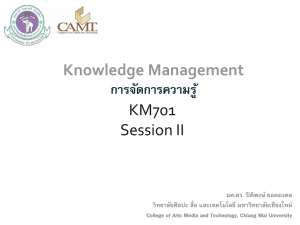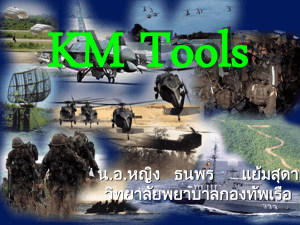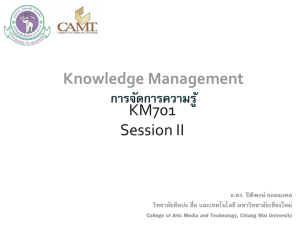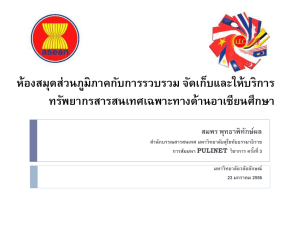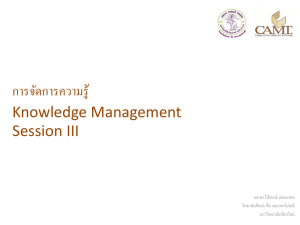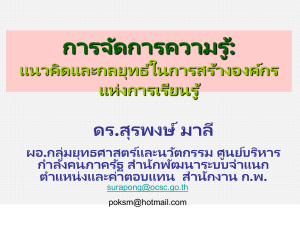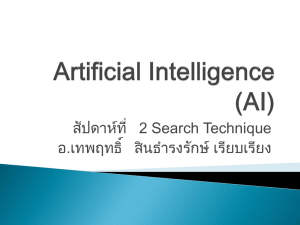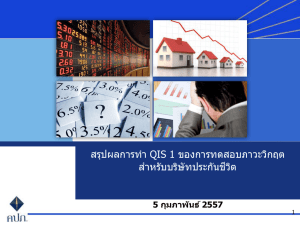ระบบสารสนเทศเพื่อการจัดการ Management Information
advertisement
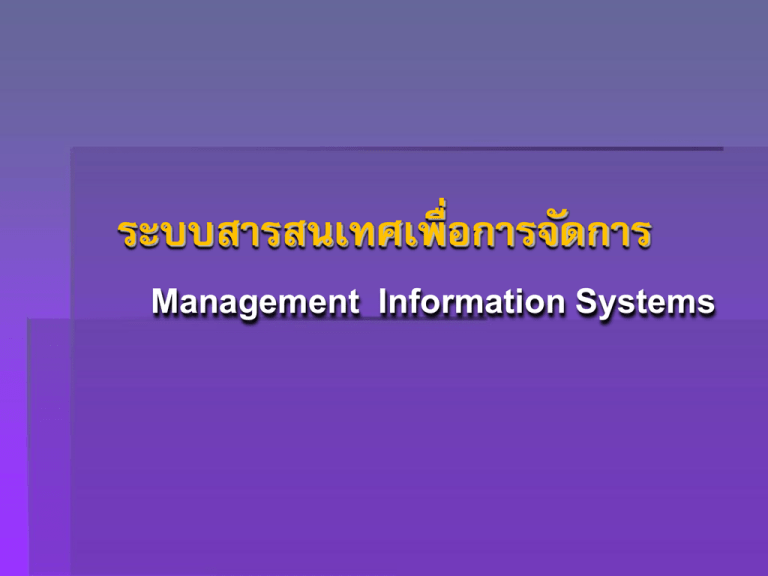
ระบบสารสนเทศเพื่อการจัดการ Management Information Systems Business flexibility & responsiveness Management Information System Increasing the Value Action Insight Empower people and processes to take the proper action… Information Transform it into useful in-context information . . . Data Integrate ever evolving data and content, from many different sources… Business value Knowledge needs to take action Data => Information=> Knowledge=> Decisions => Success Data Information Insight Action Accuracy, Relevance, Timeliness, Significant & Meaning-full เทคโนโลยีสารสนเทศและการสื่อสารทาให้เกิดการ เปลี่ยนแปลงหรือปฏิรูปในธุรกิจ ตัวอย่างเช่น –Wireless technology, Web technology –Web 2.0 –Cloud Computing –Internet ได้เพิ่มโอกาสและความท้าทาย ในการดาเนินธุรกิจในยุคโลกาภิวตั น์ Be prepared for change. Rapidly changing environment drives need for innovation 5 What’s on the minds of 450 of the world’s leading CEOs? CEO needs CIO challenges Revenue growth with cost containment Aligning IT and business goals to grow revenue and contain costs Key competency: responsiveness Building responsiveness and agility into the organization through IT Critical success factor: enable effectiveness of 6 people and processes How can IT help enable people and teams to be more effective Strategic Business Objectives •การดาเนินงานที่เป็ นเลิศ •สร้างสินค้าและบริการใหม่ๆ รูปแบบการดาเนิน ธุรกิจใหม่ •สร้างความสัมพันธ์อนั ดีกบั ลูกค้าและคู่คา้ •เพิ่มความถูกต้องในการตัดสินใจ •สร้างความได้เปรียบในการแข่งขัน •เพื่อความอยูร่ อดของธุรกิจ New products, services, and business models: Apple’s iPod, iTunes, iPhone, iPad, Google’s Android OS, and Netflix Customer and supplier intimacy •โรงแรมหรูระดับห้าดาวที่มีการใช้ระบบสารสนเทศ ในการติดตามการใช้บริการของลูกค้า เพื่อนาข้อมูล ดังกล่าวมาปรับปรุงการให้บริการลูกค้า •ธุรกิจค้าปลีกประเภทโมเดิรน์ เทรด เชื่อมโยงระบบ ขายสินค้าเข้ากับซัพพลายเออร์ Improved decision making -หากปราศจากข้อมูลหรือสารสนเทศมักตัดสินใจโดยวิธี • คาดการณ์ เดาจากประสบการณ์ หรือโชคช่วย • อันนามาซึ่ง - Overproduction, underproduction of goods and services - Misallocation of resources - Poor response times • ผลลัพธ์ที่ตามมาคือ ต้นทุนเพิ่มขึ้น หรือสูญเสีย ลูกค้า การลงทุนใน ICT •คอมพิวเตอร์ฮาร์ดแวร์และซอฟต์แวร์ •เทคโนโลยีที่ใช้ในการจัดการข้อมูล •ระบบเครือข่าย ไม่ว่าจะเป็ น Internet, Intranet และ Extranet การลงทุนในICT กล่าวโดยสรุปได้ว่าธุรกิจลงทุนในเทคโนโลยี สารสนเทศเพื่อ ใช้สาหรับเป็ นเครื่องมือในการสร้างคุณค่า (value)ให้กบั ธุรกิจ มุ่งหวังต่อผลลัพธ์ คือ เพิ่มผลิตภาพ(Productivity increases) เพิ่มรายได้ (Revenue increases) เพื่อการวางตาแหน่งเชิงกลยุทธ์ที่เหนือกว่าคู่แข่งขัน ในระยะยาว(Superior long-term strategic positioning) ประเด็นที่ตอ้ งให้ความสนใจ การลงทุนมากมายในเทคโนโลยีสารสนเทศไม่ได้เป็ น หลักประกันว่าธุรกิจจะได้รบั ผลตอบแทนที่ดีเสมอไป Perspectives on Information Systems Information Systems Are More Than Computers Organization Dimension •โครงสร้างองค์การและสายการบังคับบัญชา •การแบ่งหน้าที่ความรับผิดชอบ •กระบวนการธุรกิจ(business process) •วัฒนธรรมองค์การ •การเมืองในองค์การ Management Dimension •กาหนดกลยุทธ์ธุรกิจให้เหมาะสมกับสภาพแวดล้อม และความท้าทายในการดาเนินธุรกิจ •สร้างสินค้าหรือบริการใหม่ๆ ออกแบบองค์การใหม่ Technology Dimension – Computer hardware and software – Data management technology – Networking and telecommunications technology • Networks, the Internet, intranets and extranets, World Wide Web – IT infrastructure: provides platform that system is built on Technology Dimension Computer hardware and software Data management technology Networking and telecommunications technology - Networks, the Internet, intranets and extranets, World Wide Web IT infrastructure: provides platform that system is built on ความสัมพันธ์ระหว่างองค์การกับระบบสารสนเทศ Systems as Planned Organizational Change Systems as Planned Organizational Change 1. Automation เพิ่มประสิทธิภาพในการทางาน ทดแทนการทางานด้วยมือ 2. Rationalization of procedures เพื่อปรับกระบวนการทางานให้มีความต่อเนื่องกัน เพื่อแก้ปัญหาเรื่องคอขวดในกระบวนการทางาน Systems as Planned Organizational Change 3. Business process redesign -ออกแบบกระบวนการดาเนินงานใหม่ -กาจัดขั้นตอนที่ไม่จาเป็ น ลดความซ้ าซ้อน 4. Paradigm shifts -ออกแบบโมเดลธุรกิจใหม่ -ปรับเปลี่ยนองค์การใหม่ Management Information Systems CHAPTER 13: BUILDING INFORMATION SYSTEMS Overview of Systems Development Systems development: Activities that go into producing an information system solution to an organizational problem or opportunity 1.Systems analysis 2.Systems design 3.Programming 4.Testing 5.Conversion 6.Production and maintenance 25 © Prentice Hall 2011 Systems Development Life Cycle ประเด็นเกี่ยวกับความล้มเหลวของโครงการพัฒนา ระบบสารสนเทศ • โครงการที่ไม่ประสบความสาเร็จ มีถึง 30%-40% ของ โครงการทั้งหมด – โครงการล่าช้า งบประมาณบานปลาย – ระบบไม่สามารถทางานได้ตามคุณสมบัตทิ ี่กาหนดไว้ • การต่อต้านจากผูใ้ ช้ เนื่องจาก – ไม่ยอมรับระบบใหม่ – กลัวการเปลี่ยนแปลง – กลัวสูญเสียความสาคัญ ประเด็นเกี่ยวกับความล้มเหลวของโครงการพัฒนา ระบบสารสนเทศ -โครงการที่ไม่ประสบความสาเร็จ มีถึง 30%-40% ของโครงการทั้งหมด •โครงการล่าช้า งบประมาณบานปลาย •ระบบไม่สามารถทางานได้ตามคุณสมบัตทิ ี่กาหนดไว้ -การต่อต้านจากผูใ้ ช้ เนื่องจาก •ไม่ยอมรับระบบใหม่ •กลัวการเปลี่ยนแปลง •กลัวสูญเสียความสาคัญ FAILURE PROFILES Project Failure Factors 1. Incomplete Requirements 2. Lack of User Involvement 3. Lack of Resources 4. Unrealistic Expectations 5. Lack of Executive Support 6. Changing Requirements & Specifications 7. Lack of Planning 8. Didn’t Need It Any Longer 9. Lack of IT Management 10. Technology Illiteracy Other The Standish Group SUCCESS PROFILES Project Success Factors 1. User Involvement 2. Executive Management Support 3. Clear Statement of Requirements 4. Proper Planning 5. Realistic Expectations 6. Smaller Project Milestones 7. Competent Staff 8. Ownership 9. Clear Vision & Objectives 10. Hard-Working, Focused Staff Other The Standish Group การลดความเสี่ยงในการนาระบบสารสนเทศมาใช้ - การจัดการการเปลี่ยนแปลง(Change Management) - บทบาทของผูเ้ กี่ยวข้อง ผูบ้ ริหาร System Analyst User กลยุทธ์ในการจัดการการต่อต้านจากผูใ้ ช้ • • • • • • ความร่วมมือของผูใ้ ช้ตลอดระยะเวลาการพัฒนาระบบ การให้ความรูแ้ ละการฝึ กอบรมการใช้งาน นโยบายและการสั ่งการของผูบ้ ริหาร การให้รางวัลสาหรับผูท้ ี่ให้ความร่วมมือ การสื่อสารเพื่อสร้างความเข้าใจไปยังผูใ้ ช้ การจัดการป้องกันปั ญหาต่างๆที่อาจเกิดขึ้นก่อนนา ระบบใหม่มาใช้ เรื่องที่กาหนดให้ศึกษา • Chapter 1 Information Systems in Global Business Today • Chapter 2 Global E-Business and Collaboration • Chapter 3 Information Systems, Organization and Strategy • Chapter 4 Ethical and Social Issues in Information Systems • Chapter 9 Achieving Operational Excellence and Customer Intimacy: Enterprise Applications เรื่องที่กาหนดให้ศึกษา • Chapter 10 E-commerce, Digital Markets, Digital Goods • Chapter 11 Managing Knowledge • Chapter 12 Enhancing Decision Making • Chapter 13 Building Information Systems • Chapter 14 Managing Projects

